

Thick Blood: Overview, Symptoms, Causes, Natural Treatments, and Medicine. Thick blood (also known as hypercoagulability, Antiphospholipids, and Hughes Syndrome) is a condition where the blood is more viscous (thicker and stickier) than normal.
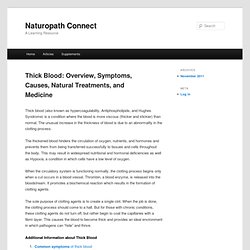
The unusual increase in the thickness of blood is due to an abnormality in the clotting process. The thickened blood hinders the circulation of oxygen, nutrients, and hormones and prevents them from being transferred successfully to tissues and cells throughout the body. This may result in widespread nutritional and hormonal deficiencies as well as Hypoxia, a condition in which cells have a low level of oxygen. When the circulatory system is functioning normally, the clotting process begins only when a cut occurs in a blood vessel.
Introduction to Cell Biology (Part I) Cells structure and function 2012. Brain. Immunity. Leukocytes. C immune. The straight dope on cholesterol – Part I. I’ve been planning to write at length about this topic for a few months, but I’ve been hesitant to do so for several reasons: To discuss it properly requires great care and attention (mine and yours, respectively).My own education on this topic only really began about 9 months ago, and I’m still learning from my mentors at a geometric pace.This topic can’t be covered in one post, even a Peter-Attia-who-can’t-seem-to-say-anything-under-2,000-word post.I feel a bit like an imposter writing about lipidology because my mentors on this topic (below) have already addressed this topic so well, I’m not sure I have anything to add.

Boron. The saliva/serum iodide ratio as an index of sodium/iodide symporter efficiency. Return The saliva/serum iodide ratio as an index of sodium/iodide symporter efficiency Guy E.
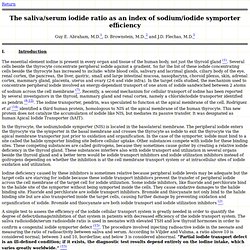
Abraham, M.D.1, D. Brownstein, M.D. 2 and J.D. Flechas, M.D.3 I. The essential element iodine is present in every organ and tissue of the human body, not just the thyroid gland (1). In the thyrocyte, the sodium/iodide symporter (NIS) is located in the basolateral membrane. Iodine deficiency caused by these inhibitors is sometimes relative because peripheral iodide levels may be adequate but the target cells are starving for iodide because these iodide transport inhibitors prevent the transfer of peripheral iodide across the cell membrane of the target cell for iodide utilization. Consequences of Iodine Deficiency.
Control tactics Health through Nutrition Practical Health The Nature of Government Further to: The Miracle Of Iodine And It's Nearly Free the miracles simply keep piling.... an essential nutrient to maintain health!
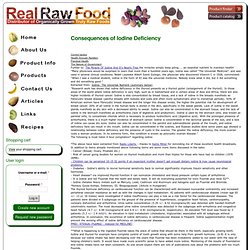
Vit-K. Contents Article Summary Main Article (On the Trail of the Elusive X-Factor)

Emotional Wellbeing(NHS) Zinc and B12 are an important team for your mental and emotional well being. In “The Townsend Letter of Doctors “, I was reading about all the B12 health benefits: everything from fighting anemia to memory and mood elevation.

While I don’t practice psychiatry, the function of the central nervous system is key in my practice. One study caught my eye. This one, (Mitsuyama et al) brought up the issue of how important zinc is in getting the B12 across the blood-brain barrier and into the central nervous system. No matter how good your B12 status, if Zinc isn’t available the vitamin won’t arrive where it’s needed. Without B12, the brain is vulnerable to a host of mental and functional difficulties.
Detox. Health and Healing. Diseases. 15 Ways to Love Your Liver. Fatty Liver ? Iodine and your Heart. Deficiency Diseases (History of Medicine) Lecture given February, 2009; Re-posted on website August 4, 2010 This is the fifth in a series of presentations given to the February-March, 2009 session of our local lifelong learning program, Senior University Georgetown.)
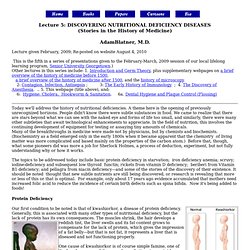
Other lectures in this series include: 1. Athletes. Introduction (start here) David Bolinsky: Visualizing the wonder of a living cell. Medicine. Cell-Wise - Home. DNA to Proteins. Myeloma. Myeloma incidence statistics. Some otherwise healthy people can produce myeloma-causing cells, resulting in the asymptomatic condition MGUS.
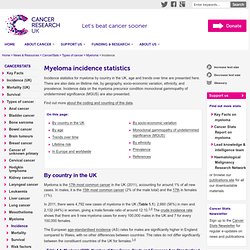
Rates of progression from MGUS to myeloma are low at around 1% per year,21 but all myeloma patients have MGUS as a precursor to their myeloma.22 Although cases of MGUS are not systematically recorded by the UK cancer registries, information on these diagnoses is routinely collected in the Haematological Malignancy Research Network (HMRN) region in the north of England. In 2004-2009 there were on average 4.9 cases of MGUS per 100,000 people per year.23 Like myeloma, MGUS is more common in men than women, with average age-standardised rates of 6.3 cases per 100,000 men and 3.5 cases per 100,000 women in the HMRN region in 2004-2010.23 UK estimates based on data from the HMRN region show that the age and sex distribution of MGUS patients is very similar to that of myeloma patients (Figure 1.7).23 Download this chart.
VELCADE® (bortezomib) Official Website.
Mitochondrial Dysfunction & CFS. Mitochondrial / Metabolic Dysfunction Printer Friendlier Version.